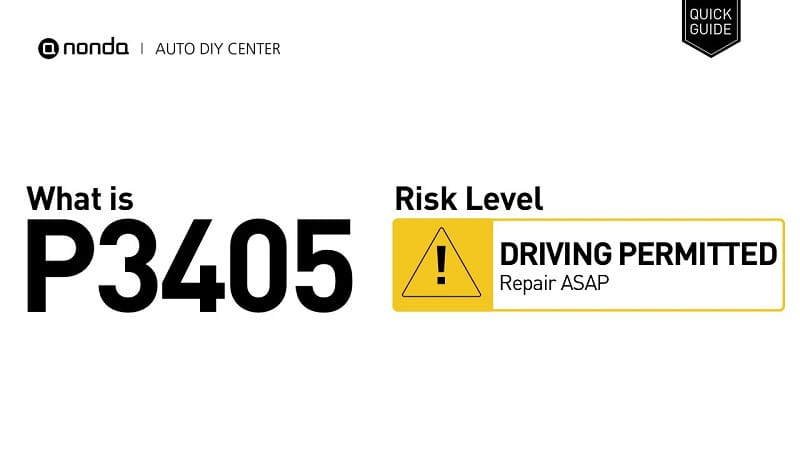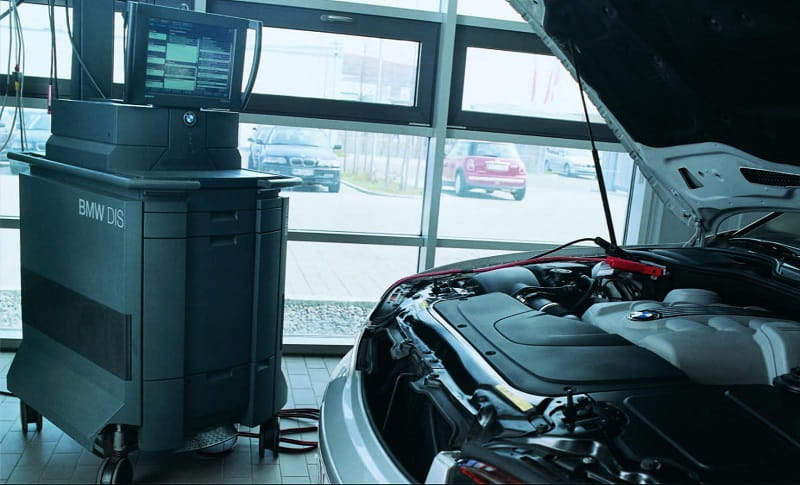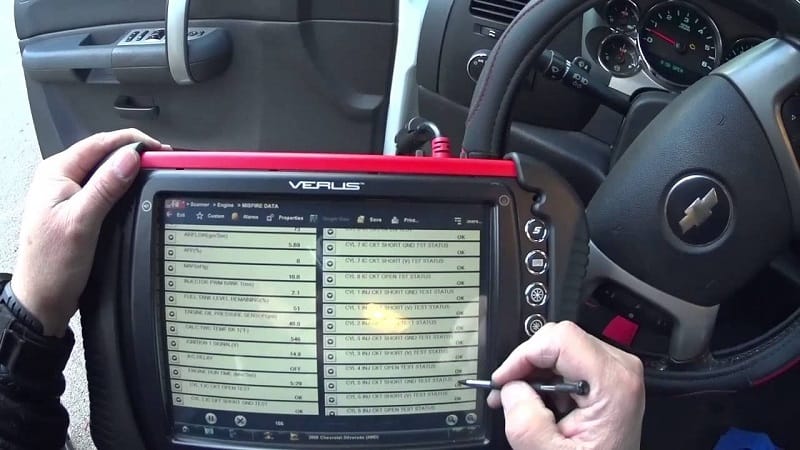This post contains affiliate links. This means I will make a commission at no extra cost to you should you click through and make a purchase [ “As an Amazon Associate, I earn from qualifying purchases.” ]. Read the full disclosure here.
Understanding P3405: Cylinder 1 Exhaust Valve Control Circuit/Open GuideMechanic.Com Modern vehicles rely on highly advanced engine control systems to maximize performance, fuel efficiency, and emissions control.
One such system involves variable valve timing and cylinder deactivation technologies, which rely on electronic and hydraulic components to precisely control engine valve operation.
The diagnostic trouble code (DTC) P3405, labeled “Cylinder 1 Exhaust Valve Control Circuit/Open,” indicates a problem in the electrical circuit that controls the exhaust valve operation for cylinder 1.
This code is particularly relevant in engines equipped with Variable Valve Timing (VVT) or Active Fuel Management (AFM) systems.
P3405 Cylinder 1 Exhaust Valve Control Circuit/Open
What Does Code P3405 Mean?

The P3405 code is triggered when the Powertrain Control Module (PCM) detects that the electrical circuit controlling the exhaust valve actuator (or solenoid) for cylinder 1 is open or malfunctioning.
An “open” circuit refers to a situation where the electrical flow is interrupted—often due to a break in the wiring, a faulty solenoid, or a disconnected harness.
In engines that use VVT or AFM, the PCM uses oil pressure and electronic signals to control the timing of the intake and exhaust valves.
When this system fails to operate the exhaust valve actuator for cylinder 1 as intended, the PCM sets the P3405 code and may disable certain features to prevent engine damage.
Key Components Involved in P3405
- Powertrain Control Module (PCM)
- Exhaust Valve Control Solenoid/Actuator (Cylinder 1)
- Wiring Harness and Electrical Connectors
- Oil Pressure Control System
- Camshaft and Valve Timing Components
These components interact to ensure the precise timing and control of exhaust valve function. An open circuit in any part of the system can impair performance and trigger the P3405 code.
P3405 Cylinder 1 Exhaust Valve Control Circuit/Open
Common Causes of P3405
Understanding the most frequent reasons behind the P3405 code can help narrow down diagnostics and repairs. The typical causes include:
Faulty Exhaust Valve Control Solenoid (Cylinder 1)
The solenoid may fail internally, resulting in an open circuit or inability to respond to PCM commands.
Broken, Frayed, or Disconnected Wires
Open circuits often result from damaged wiring due to engine heat, vibration, corrosion, or rodent damage.
Loose or Corroded Electrical Connectors
A poor connection can simulate an open circuit, especially near solenoids or sensors exposed to oil and moisture.
P3405 Cylinder 1 Exhaust Valve Control Circuit/Open
Faulty PCM or ECM (Rare)

If all other components are in working order, the control module itself may be defective or experiencing software glitches.
Low or Contaminated Engine Oil
VVT systems rely on clean oil and stable oil pressure. Low oil levels or dirty oil can interfere with actuator performance.
P3405 Cylinder 1 Exhaust Valve Control Circuit/Open
Symptoms of P3405
The symptoms of a P3405 code may vary depending on the vehicle’s make, model, and how the PCM responds to the issue. Common symptoms include:
- Illuminated Check Engine Light (CEL)
- Reduced Engine Power or Limp Mode
- Rough Idle or Engine Vibration
- Poor Acceleration
- Decreased Fuel Efficiency
- Engine Misfire (Especially at Low RPM)
- Increased Exhaust Emissions
In many vehicles, a failed exhaust valve actuator will force the PCM to disable VVT or AFM functions entirely, causing a noticeable drop in engine performance.
Diagnosing P3405
Proper diagnosis is essential to resolving the P3405 trouble code efficiently. The following steps outline how a mechanic—or a skilled DIYer—might diagnose the issue:
1. Scan for Trouble Codes
Use an OBD-II scanner to verify the presence of P3405 and check for any related codes, such as P3400 (cylinder deactivation system error), P3404 (intake valve control), or oil pressure DTCs.
2. Perform a Visual Inspection
Inspect the wiring and connectors related to the exhaust valve control solenoid for cylinder 1. Look for:
- Cracked, burnt, or frayed wires
- Loose or corroded connectors
- Oil-soaked plugs near the solenoid
3. Test the Solenoid
Remove the solenoid and test it using a digital multimeter:
- Measure the resistance across the terminals. A normal reading might range from 10 to 20 ohms, depending on the manufacturer’s specifications.
- An “infinite” reading (open loop) indicates the solenoid is faulty.
4. Check Circuit Continuity
Using a multimeter, check continuity between the PCM and the solenoid connector. An open or broken wire will show no continuity.
5. Verify Oil Condition and Pressure
Check oil level and ensure it’s full and clean.
If needed, use a mechanical oil pressure gauge to confirm that the engine maintains adequate oil pressure during operation.
6. PCM Function Test
If all components appear to be functioning, the PCM may need further testing or reprogramming. In rare cases, PCM replacement is required.
P3405 Cylinder 1 Exhaust Valve Control Circuit/Open
How to Fix P3405

Once the problem has been identified, the following repair options may be used to fix P3405:
Replace Faulty Exhaust Valve Control Solenoid
If the solenoid is malfunctioning or open, replacing it is the most direct solution.
Repair or Replace Wiring
If you find damaged or broken wires, repair them using solder and heat-shrink tubing, or replace the harness if damage is extensive.
Clean and Reconnect Corroded Connectors
Use electrical contact cleaner and a small brush to clean connectors, and ensure a snug, secure fit.
Change Engine Oil and Filter
Dirty oil can impair VVT and AFM systems. Use manufacturer-recommended oil type and viscosity.
Replace PCM (If Necessary)
Only after all other options have been exhausted should you consider PCM replacement. Ensure correct programming and VIN configuration.
P3405 Cylinder 1 Exhaust Valve Control Circuit/Open
Preventing Code P3405
While not all vehicle issues are preventable, you can significantly reduce the risk of P3405 and similar codes by following these best practices:
- Perform Regular Oil Changes using high-quality oil and filters.
- Inspect Electrical Connections and Harnesses during maintenance visits.
- Avoid Low-Quality Replacement Parts for solenoids and sensors.
- Address Check Engine Lights Promptly before they lead to bigger problems.
- Monitor for Unusual Engine Behavior, especially rough idling or loss of power.
Vehicles Commonly Affected
The P3405 code is often seen in vehicles equipped with VVT or AFM systems, especially:
- General Motors (GM) vehicles with V8 engines using AFM
- Honda and Acura engines with VTEC and VCM systems
- Chrysler/Dodge engines with MDS (Multi-Displacement System)
Each manufacturer may use different terminology for their variable valve and cylinder deactivation systems, but the core principles and diagnostic approach remain similar.
Conclusion
The P3405: Cylinder 1 Exhaust Valve Control Circuit/Open diagnostic code highlights a fault in the electrical control of exhaust valve actuation for the first cylinder.
While it may seem like a small issue, it can have a major impact on engine performance, efficiency, and emissions if left unaddressed.
With proper diagnostic steps and regular maintenance—especially oil system care—you can resolve P3405 efficiently and avoid further engine complications.
If you’re unsure about handling the repair yourself, it’s always best to consult a professional technician who can pinpoint the issue using advanced tools and manufacturer-specific procedures.
- Lifted Turbo Diesel Trucks for Sale - December 7, 2025
- American Classic Pickup Trucks for Sale UK - December 6, 2025
- Old Classic Pickup Trucks for Sale Near Me - December 5, 2025
